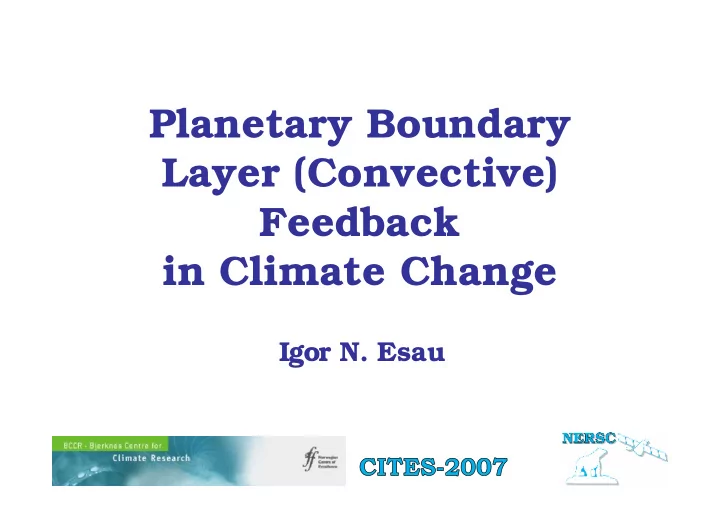

Planetary Boundary Layer (Convective) Feedback in Climate Change Igor N. Esau
Outline • Impact of vertical turbulent mixing in formation of Earth near surface climate • Control parameters and integral measures of the vertical turbulent mixing • Sensitivity of earth’s climate to variability of the vertical turbulent mixing • Some instructive predictions following from the PBL-feedback
Mechanisms of Equilibrium and Stationary PBL-feedback Manabe et al. 1960s discovered cooling effect of turbulent convection (by – 44 o K on earth’s surface), which transports heat (moisture, aerosols) above the optically thick atmosphere
Mechanisms of Equilibrium but Non-stationary PBL-feedback Shallow mixing H Difficult to see in the Mean SAT atmosphere but easy in greenhouse experiment sunset sunrise sunset Deep mixing π 2 1 R ( t ) ∫ = dT dt ρ c H t ( ) p 0 dT
Demonstration: PBL-feedback in Greenhouse • Greenhouse limits mixing (R. Wood, 1909), i.e. H, amplifying DTR and particularly maximum SAT • On average greenhouse is warmer than outside air • Strong irradiation during clear but windy nights can cause excessive cooling in the greenhouse
Integral Measure of Turbulence • PBL-feedback could be integrally expressed through PBL thickness, H • Difficulty is that H depends on external, variable parameters Zilitinkevich, Esau, Baklanov, QJRMS 2007 Zilitinkevich 1991
Verification of Theoretical Results (black line) versus LES (red) and SHEBA (blue)
Statement • Given distribution of the radiative heat flux divergence in the absence of advection and changes in the atmospheric optical thickness produces higher (lower) surface temperatures in shallow (deep) PBL • The effect should be the most pronounced in stably stratified PBL as the relative variability dH/ H and c p ρ dH/ R are much larger in those PBL
PBL-feedback in Stably Stratified Layers • Convection and its feedbacks were studied in details over last 40 years • Nocturnal and polar shear-driven PBL feedbacks were studied fragmentary • Impacts of several Surface sensible heat flux for December important governing 1959-1997 from NCEP/NCAR Reanalysis parameters were project. missing
Correlation between H and T in wintertime Arctic Shallow PBL is colder
PBL Depth: CHAMP versus ERA-40 Less sensitive – More sensitive • Convective layer thickness (PBL depth) as the altitude of minimum relative humidity gradient: left – by the CHAMP (GPS) satellite for all (87598) occultations during 2002-03, data is averaged over a 5 by 5 grid; right – by ERA40 ECMWF data (same time). Courtesy Engeln and Teixeira (2004; 2005)
Physical Inconsistency of Models Too deep PBL – Reduced sensitivity • H is difficult to routinely determine (remote sensing) in the real atmosphere (ocean?) • In models, H is strongly inconsistent with theory, LES and field campaigns
Insufficient Sensitivity of IPCC models • Rahmstorf et al. (Science, 2007) revealed insufficient sensitivity of the IPCC models relative to observed climate sensitivity
Climate Sensitivity to PBL-feedback • PBL-feedback gives inverse climate sensitivity to mixing layer depth ( ) π π Ψ 2 2 dT 1 d R ( t ) / H ( t ) 1 d ∫ ∫ = = dt dt , ρ ρ dR c dR c dR p p 0 0 where Ψ − d 1 R dH ≡ 1 dR H H dR
H and Temperature Trend Temperature trends are larger in shallow PBL
Global Climate Sensitivity to PBL-feedback in ERA40
Predictive Signature of PBL-feedback • Where the PBL- feedback could be find? • Is there any distinct signatures of the PBL- feedback? • PBL-feedback relatively increases in shallow layers • Climate change in shallow PBL should be amplified
Diurnal Temperature Range • Observed: Min T is increasing nearly 3 times as fast as the mean T • Result in decrease of DTR • Observed: Wintertime mean T increase nearly 2 times as fast as the annual averaged T
Sensitivity to Lapse Rate from LES • Sensitivity to Lapse Rate depends on heat flux • Changes in surface T is not necessarily reflect direction of the global climate change
Conclusions • Earth’s climate needs cooling • Cooling is regulated by PBL-feedback • PBL-feedback depends on limitations of the convective layer thickness • Limitations are strong • Stronger limitations makes climate more sensitive to shifts in radiation balance
Auxiliary Materials To answer questions
Recommend
More recommend